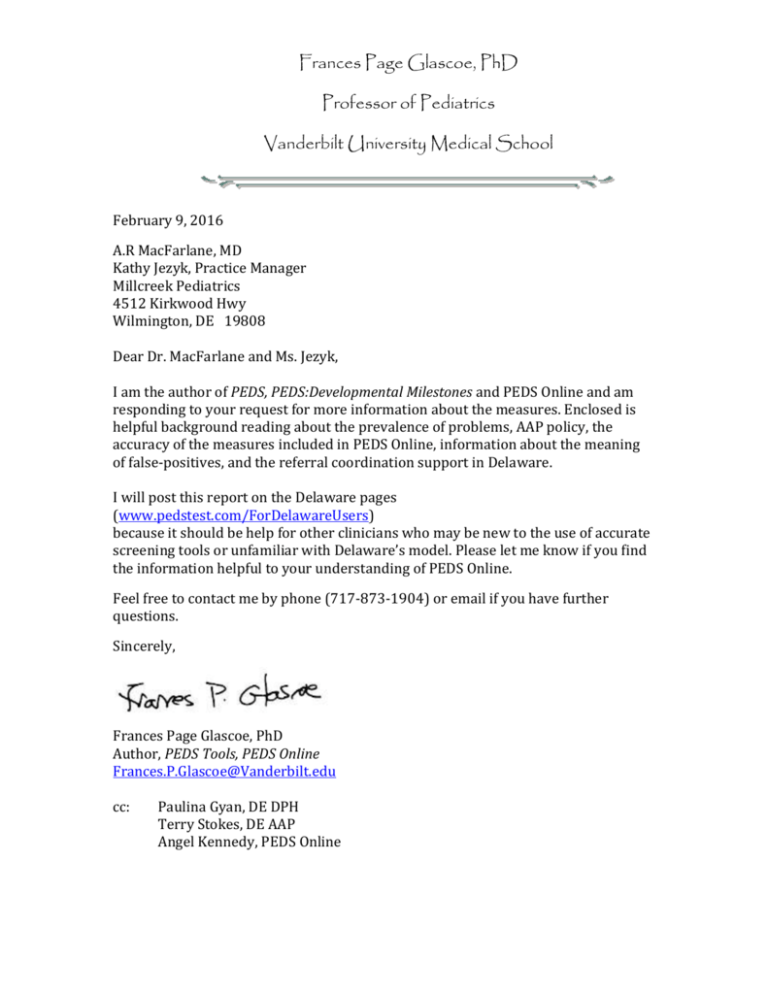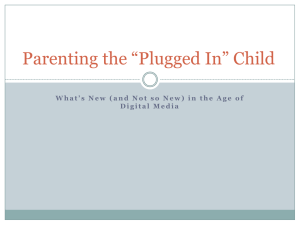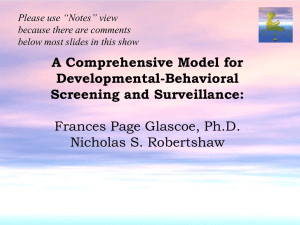Click here to open a document
advertisement

Frances Page Glascoe, PhD Professor of Pediatrics Vanderbilt University Medical School February 9, 2016 A.R MacFarlane, MD Kathy Jezyk, Practice Manager Millcreek Pediatrics 4512 Kirkwood Hwy Wilmington, DE 19808 Dear Dr. MacFarlane and Ms. Jezyk, I am the author of PEDS, PEDS:Developmental Milestones and PEDS Online and am responding to your request for more information about the measures. Enclosed is helpful background reading about the prevalence of problems, AAP policy, the accuracy of the measures included in PEDS Online, information about the meaning of false-positives, and the referral coordination support in Delaware. I will post this report on the Delaware pages (www.pedstest.com/ForDelawareUsers) because it should be help for other clinicians who may be new to the use of accurate screening tools or unfamiliar with Delaware’s model. Please let me know if you find the information helpful to your understanding of PEDS Online. Feel free to contact me by phone (717-873-1904) or email if you have further questions. Sincerely, Frances Page Glascoe, PhD Author, PEDS Tools, PEDS Online Frances.P.Glascoe@Vanderbilt.edu cc: Paulina Gyan, DE DPH Terry Stokes, DE AAP Angel Kennedy, PEDS Online 2 3 BACKGROUND READING FOR CLINICIANS IN DELAWARE Developmental-Behavioral Problems in Young Children: Prevalence, Enrollment in Early Intervention, and Findings from the Delaware Screening Initiative Prevalence The Centers for Disease Control holds that ~ 14% of children in the 3 to 18 year age range have developmental-behavioral (also meaning social-emotional/mental health) disabilities or substantive delays, although the CDC also cites several studies showing prevalence of 16% -18%. High school drop out rates average 16% nationally but rates can reach 40% or higher among children at psychosocial risk (e.g., inner city poor). Most of these students had developmental/academic delays and/or mental health problems but did not receive the benefits of early intervention. In 0 to 3 year-year-olds, prevalence across several studies cited by the CDC ranges from 9% to 13%: www.cdc.gov/ncbddd/childdevelopment/data.html. For more information on prevalence see: http://www.cdc.gov/ncbddd/developmentaldisabilities/features/birthdefects-ddkeyfindings.html Conditions Most children with disabilities and delays neither have identifiable biological problems (such as traumatic birth histories, prematurity, inborn metabolic errors) nor genetic conditions resulting in dysmorphology. Some, but not all children, have developmental-behavioral deficits due to psychosocial risk factors (e.g., poverty, limited parental education) and may also lack resilience or protective factors (usually meaning positive parenting). For these reasons, the American Academy of Pediatrics’ policies on early detection1-5 recommend routine screening using: a) a measure eliciting and addressing parents’ concerns; b) a measure of milestones; and c) a periodic screen for autism spectrum disorder. The AAP also recommends combining screening tests with surveillance which is the use of clinical acumen to detect physical conditions (such as hearing or visual impairments, elevated tone associated with cerebral palsy) and the use of psychosocial risk and resilience screens. In any case, early detection focuses on the asymptomatic. Children with obvious difficulties can simply be referred for evaluations through IDEA necessary for determining eligibility. IDEA evaluations are much aided when providers document any physical, medical, sensory, or health conditions that may contribute to developmental-behavioral deficits. How Early Intervention Helps and… What is Early Intervention? Early intervention is thoroughly established as an effective means of reducing secondary mental health problems, limiting teen pregnancy, criminal behavior and adjudication, improving high school graduation rates and employment rates. The effects of early intervention are clearly profound and save tax-payers ~ $17.00 for each $1.00 spent.6-9 4 Early Intervention is often construed to mean special education services for children with disabilities. But early intervention (with a lower case “e” and “i”) encompasses much more –Head Start, Early Head Start, quality day care, parenting programs, mental health services for parents, social work interventions, etc. Ideally, we intervene with children well before school entrance so that they begin kindergarten with the necessary complement of skills to succeed. School failure is a miserable experience that leads to mental health problems, and to dropping out of high school. But we cannot determine who needs help and what kind of help is needed unless we detect problems in the first place.1-5,10 Detection/Enrollment Rates In the US where State Centers for Medicaid and Medicare require for payment/reimbursement, deployment of accurate screening tests (the most common are ASQ Tools and PEDS Tools along with a periodic screen for autism spectrum disorders such as the MCHAT-R), enrollment rates in programs funded through the Individuals with Disabilities Education Act (IDEA) for Part C (birth to 3 years) are 7% (e.g., Massachusetts, Hawaii). In States where quality screens are not required and providers rely on informal checklists or untested questions to parents, enrollment rates are substantially lower (www.ideadata.gov) Prior Enrollment Rates In Delaware Because IDEA services must report annually to Congress, Delaware’s enrollment rates were found to be among the lowest in the nation despite eligibility criteria similar to that of Massachusetts and Hawaii (http://www2.ed.gov/about/reports/annual/osep/2013/parts-b-c/35th-ideaarc.pdf) DE Screening Initiative As a consequence of low enrollment rates in IDEA Part C, the DE Division of Public Health, the Nemours Health Prevention Services and the DE AAP supported by multiple non-medical service providers, petitioned for legislative funding to offer no-cost, high quality screening to all Delaware families, beginning with screening in primary care. Additional impetus and advocacy was provided by the then Lieutenant Governor, Matt Denn, who has a child with disabilities. Under the leadership of DE DPH, the Healthcare Provider Outreach work team of the Help Me Grow Advisory Committee led an effort to streamline referrals following feedback from providers that referral coordination was needed to ensure that children who fail screens, while not qualifying for Child Development Watch (CDW, which is DE's IDEA Part C) still need other types of services (e.g., Head Start/Early Head Start). The 2-1-1/Help Me Grow Child Development Specialists were then engaged to assist with making those referrals to community services. 2-1-1/Help Me Grow call center is used for non-emergent 5 assistance such as housing or food instability, but also to help parents' struggling with behavioral or developmental problems -with advice but also with access to a range of helpful programs. Efforts to Assist Primary Care Providers After reviewing a range of available screening tools, the Division of Public Health adopted PEDS Online because of its accuracy, compliance with AAP policy on early detection, brevity, and focus on primary care. PEDS Online is a web-based service that enables providers to complete 1 or more screening tests. Tests are automatically scored, results rendered, and the site generates referral letters, takehome parent summary reports (as recommended by the AAP's Bright Futures Initiative) and ICD-9/10 procedure codes for billing and payment reimbursement. The site generates a database for each clinic and enables DE DPH to identify uptake by clinics. CDW and HMG will be able to view results and assist providers with referrals. The Delaware Academy of Medicine created a series of videos on how to use PEDS Online and what to do with the results. DE DPH created a referral algorithm (designed to be posted in every exam room) to help providers identify which children with problematic screens need to be referred to CDW or instead to HMG. DE AAP provides training and technical assistance to providers. www.pedstest.com/ForDelawareUsers Findings from PEDS Online The numbers of children screened since the onset of the Delaware Screening Initiative in 2010 has steadily increased. In 2014, more than 18,000 Delaware children between 0 to 8 years of age received screening through primary care clinics. Among all children screened in 2014, 13,356 screens were administered in the 0 to 3 year age range. This figure indicates that almost 1/3rd of very young Delawareans received screening via PEDS Online through primary care clinics—an impressive figure -- but more to go! Of the 13,356 screens administered to 0 to 3 year olds, 79% passed all screening tests administered, while 3% met DE referral algorithm criteria for high risk (indicating the need for a CDW referral) and 18% were at moderate risk (suggesting a HMG referral if needed –although many moderate risk referrals include health issues that can be addressed in primary care, as can many aspects of developmentalbehavioral promotion. Repeated issues not responsive to brief advice deserve a referral to HMG). PEDS Online Performance and CDW/HMG Referrals 6 The table below shows frequencies of high, moderate and low risk performance on PEDS Online, i.e., the referral rates suggested for CDW and potentially for HMG (with provisos as above). Also shown are the numbers of children referred to CDW and HMG (including all ages for HMG), followed by the numbers and percent of children qualifying for CDW services (HMG does not have eligibility criteria). Because other programs including HMG, day care, home visiting, private speechlanguage services, Autism Society, etc. also refer to CDW (just as CDW refers to HMG when needed), not all referrals to CDW or HMG were a result of PEDS Online. This is visible in CDWs much higher than expected referral rate compared to PEDS Online results. In any case, providers, if following the DE referral algorithm, can expect to refer about 3% of children in the 0 – 3 year age range to CDW and will find most of them eligible for services. If not, CDW will refer to HMG. Table 1. PEDS Online Performance and CDW/HMG Referrals in 2014 PEDS Online Results Frequenc Percent y Actual Referrals (N’s) Qualifying % of Referrals to Qualifying CDW (N’s) Referrals to CDW 79.1 15 (to CDW)** 8 -- No-referral 10569 needed (low risk) HMG 2354 17.6 2662 NA -(moderate risk) CDW 433 3.2 2059 (+ 15 low 1760 + 85% (high risk) risk) = 2074* 8/2074* Total 13356 100.0 4,736 *of the 2074 referrals to CDW, 1768 (or 85%) were eligible for Part C or for ongoing tracking and assessment by CDW **Note that in all low-risk referrals, providers had not included their own comments on the PEDS’ Response Form Issues with children 3+Years of Age A point of frustration for many providers is referring to IDEA Part B (3 – 22 yearold) services only to find that, despite poor performance on screening tests, children do not qualify. It is important to note these issues: Special education services have stringent eligibility criteria and many children who qualified for Part C will not be eligible for Part B once they turn 7 3 Public schools have a range of other services that can help children who are behind but not eligible for special education including curricular modifications, teacher consultation, behavior management programs, guidance counseling, summer school, etc. Because public school services are numerous and navigating them is difficult for parents and providers, it is wise to refer to HMG for assistance with monitoring and advocacy and with finding outside sources such as mentoring, after-school tutoring, etc. Other Considerations and Planning Ahead Future efforts with the DE Screening Initiative will include exploring work with the public schools to determine if the DE referral algorithm should be tightened for children 3 years and older. In addition, DE DPH plans to issue a quarterly report to providers to show their screening rates in comparison with percentages for the State as a whole. Ongoing work with CDW and HMG may enable DE DPH to match screens with referrals and eligibility. Ongoing training will include exploring CME offerings on the DE screening and referral process. PEDS Online is working toward customizing referral letters and parent summary reports so that contact information for CDW and HMG are included. What to Expect When Switching from Informal to Accurate Screening Tests Providers new to the use of accurate screening tools may wonder why their detection rates are so much higher than when they’d used informal methods (e.g., checklists built into EHR’s age-specific encounter forms). Much is known about the differences. Informal approaches detect only 30% of children who are eligible for special services. Accurate screens detect almost 3 times as many children, i.e., 80% to 90% of those with disabilities.1-5,10-12 Increased rates of screening test failures can be frustrating for providers who need to answers to questions such as: Where to refer? What if parents don’t follow through? What if they follow through but children don’t qualify? Fortunately for clinicians in Delaware, DE DPH provides excellent referral and care coordination support, via CDW and HMG (with both services communicating with each other and with public school special services). For parents who may not be ready to follow through, providers can use any of the following approaches that are known to help: 8 Print out the parent summary report provided by PEDS Online and share this with families before they leave the clinic Email or print/fax the PEDS Online referral letter to referral sources And…ask the parent if they are willing to be called by CDW or HMG to discuss results Schedule a rescreening appointment in 6 or so weeks and ask other family members to attend (parents, mothers most often it seems, are sometimes met with resistance by spouses, their own parents, etc.) Rather than giving families a phone number to call, ask one of your staff to make the referral call while parents are still in the clinic. This is particularly essential when parents are not English-speaking. Additional Information About the Screening Tools Within PEDS Online PEDS Online includes 3 measures all of which can be completed by parent selfadministration/report, assuming literacy and ability to speak English or Spanish. If so, parents can complete measures online from home which are sent to their providers (parents do not see results) or via paper-pencil in waiting rooms (with staff entering results) or by interview in the case of literacy or language barriers (e.g., by using Language Line, in which case, a copy of the official translations need to be sent to the interpretation service):13 1. Parents’ Evaluation of Developmental Status (PEDS)14 –10 questions eliciting parents’ verbatim concerns across domains, and assigning levels of risk according to children’s age and the type of concerns raised. PEDS provides decision-support about how to address parents’ concerns, i.e. when to refer, when to screen further, and when to advise parents. When advice is needed, the content of PEDS helps providers know the exact topic to address in developmental-behavioral promotion. For example, it isn’t enough to know that parents have a behavioral concern, clinicians need to know whether the issue is temper tantrums, biting, hitting, etc. Very different advice is needed for each.15 Nemours www.kidshealth.com is an excellent source of parenting information/printable handouts. PEDS is also known to reduce “oh by the way” concerns, focus visits on the “teachable moment”, shorten visit length as a consequence, increase parent and provider satisfaction with care, and encourage parents to return for subsequent visits.16-18 (See www.pedstest.com/research for abstracts and papers). Note that PEDS prompts providers to add their own concerns and observations before scoring. For example, a parent’s concern about a 12 month old not walking is usually not worrisome (and would result in assignment of low-risk 9 status on PEDS) but if the results of the physical exam uncover hemiplegia or other significant physical problems, clinicians should note that before scoring. This will render a moderate to high risk score on PEDS which then prompts for a referral. A case example is available on www.pedstest.com/ForDelawareUsers PEDS enjoys 41 thoroughly vetted translations and has been the focus of more than 25 international studies and 47 accuracy studies in the US and Canada. Of the 47, 44 were positive. Of the three negative studies, researchers failed to interview parents when nothing was written on the PEDS Response Form (per the test’s explicit directions and why PEDS Online will not score PEDS without comments from parents).14 2. PEDS: Developmental Milestones (PEDS:DM)19 consists of 6 – 8 milestones questions, 1 per domain (expressive language, receptive language, gross motor, fine motor, self-help, social-emotional, and for older children, academic/preacademic skills in math and reading). Unlike informal checklists, PEDS:DM questions are standardized (meaning all parents and providers ask the questions the same way at each administration) and scoring criteria is thoroughly defined. For example, informal checklists may include “Knows Colors”. What does that mean? Which colors? How many? Point when named? Name when pointed to? Yuck! PEDS:DM, in contrast, identifies what is an age-appropriate skill and what is not via multiplechoice response options. Like PEDS, the PEDS:DM can be self-administered by parents who, with older children, are prompted to ask children to perform various tasks. But the PEDS:DM can also be administered directly to children by providers, via a combination of interview, observation or by eliciting children’s skills using the same directions as parents would. Flexible approaches are helpful when the accompanying parent is less than familiar with the child (e.g., new foster parent, teen parent who is not doing much actual care-taking). The PEDS:DM also enjoys many validity studies which are housed on www.pedstest.com/research The measure also has numerous translations. Digital files for translations are provided for both PEDS Tools with a link to translations for the following measure: Note that PEDS and the PEDS:DM are designed to be used together. This ensures compliance with AAP policy (eliciting and addressing parents’ concerns and measuring milestones. 92% of Delaware’s practices use both tools at each visit. 3. Modified Checklist of Autism in Toddlers – Revised (MCHAT-R) www.mchatscreen.com While PEDS and the PEDS:DM address much of AAP policy on early detection, the AAP also recommends use of an autism specific screen at 18 months and again at 24 – 30 months (or whenever there are problematic findings on other screens). PEDS Online includes the Modified Checklist of Autism in Toddlers – Revised (MCHAT-R) 10 which consists of 20 yes-no questions focused exclusively on autism spectrum disorder. The revised version now provides examples to reduce confusion about the intent of each item. The MCHAT-R is designed to be used along with broad-band screens and for this reason, PEDS Online does not allow providers to use the MCHAT-R as the only screen –children with more common problems will be missed. The MCHAT-R calls for a follow-up interview if 3 – 7 items are missed. The interview is too long for primary care and so is not included within PEDS Online (although providers can download a copy from the MCHAT-R website. The referral letters generated by PEDS Online prompt CDW, public schools or HMG to administer the interview so as not to over-refer to already strapped autism specialty clinics (where the waiting list often exceeds 9 months). In other words, always refer first to IDEA Part C, Part B, or HMG so that children do not wait without intervention when autism is suspected. The MCHAT-R enjoys multiple translations and is the focus of numerous studies of its accuracy. See www.mchat-screen.com PEDS Tools Accuracy Studies Including Information about OverReferrals/False-Positives Both PEDS and the PEDS:DM have between 84% to 86% sensitivity and 83% - 84% specificity14,19 (see www.pedstest.com/research for abstracts). The MCHAT-R has 90% sensitivity and specificity. Over-referrals (meaning children who fail screens but do not qualify for IDEA Part B or Part C) will occur. Nevertheless, 70% of overreferred children have delays and psychosocial risk factors suggesting both present problems and future problems with school success.20-22 When in doubt, refer, don’t defer. When unsure where to refer, contact HMG. References and Further Reading 1. American Academy of Pediatrics, Council on Children With Disabilities; Section on Developmental Behavioral Pediatrics; Bright Futures Steering Committee; Medical Home Initiatives for Children With Special Needs Project Advisory Committee. Identifying infants and young children with developmental disorders in the medical home: an algorithm for developmental surveillance and screening. Pediatrics. 2006;118(1):405–420 2. Weitzman C, Wegner LM, the Section on Developmental and Behavioral Pediatrics, Committee on Pyschosocial Aspects of Child and Family Health, Council on Early Childhood, and Society for Developmental and Behavioral Pediatrics. Promoting Optimal Development: Screening for Behavioral and Emotional Problems. Pediatrics. 2015;135(2):384–395. 3. Johnson CP, Myers SM and the American Academy of Pediatrics’ Council on 11 Children with Disabilities. Identification and evaluation of children with autism spectrum disorders. Pediatrics. 2007;120(5):1183–1215. 4. High PC, the Committee on Early Childhood, the Committee on Early Childhood, Adoption, and Dependent Care and Council on School Health. School Readiness. Pediatrics. 2008;121(4):e1008-e15. 5. American Academy of Pediatrics. The Future of Pediatrics: Mental Health Competencies for Pediatric Primary Care. Pediatrics. 2009;124(1):410-21. 6. Reynolds AJ, Temple JA, Ou SR, Arteaga I, White B. School-Based Early Childhood Education and Age-28 Well-Being: Effects by Timing, Dosage, and Subgroups. Science. 2011:333(6040):360-364. 7. Reynolds AJ, Temple JA, White B, Ou S, Robertson DI. Age-26 cost-benefit analysis of the Child-Parent Center early education program. Child Development. 2011; 82(1):379-404. 8. Schweinhart LJ, Montie J, Xiang Z, Barnett WS, Belfield CR, Nores M. Lifetime effects: The HighScope Perry Preschool study through age 40. Monographs of the HighScope Educational Research Foundation. Ypsilanti, MI: HighScope Press, 2005. 9. Muennig P, Schweinhart L, Montie J, Neidell M. (2009). Effects of a prekindergarten education intervention on adult health: 37-year follow-up results of a randomized controlled trial. American Journal of Public Health. 2009;99(8), 1431–1437. 10. Glascoe FP, Marks KP, Poon JK, Macias MM, eds. Identifying and Addressing Developmental-Behavioral Problems: A Practical Guide for Medical and Nonmedical Professionals, Trainees, Researchers and Advocates. Nolensville, Tennessee: PEDStest.com, LLC; 2013 www.amazon.com 11. Radecki L, Sand-Loud N, O'Connor KG, Sharp S, Olson LM. Trends in the use of standardized tools for developmental screening in early childhood: 2002– 2009. Pediatrics. 2011;128(1):14-9. 12. Bethell C, Reuland C, Schor E, Abrahms M, Halfon N. Rates of parent-centered developmental screening: disparities and links to services access. Pediatrics. 2011;128(1):146-55. 13. Glascoe FP. Evidence-Based Early Detection of Developmental-Behavioral Problems In Primary Care: What to Expect and How to Do It. Journal of Pediatric Health Care. 2015;29:46-53. 14. Glascoe FP. Collaborating with Parents:Using Parents’ Evaluation of Developmental Status (PEDS) to Detect and Address Developmental and Behavioral Problems (2nd Edition). Nolensville, TN: Pedstest.com, 2013. www.pedstest.com 12 15. Glascoe FP, Trimm F. Brief Approaches to Developmental-Behavioral Promotion in Primary Care: Updates on Methods and Technology. Pediatrics. 2014 ;133:884-897. 16. Schonwald A, Huntington N, Chan E, Risko W, Bridgemohan C. Routine Developmental Screening Implemented in Urban Primary Care Settings: More Evidence of Feasibility and Effectiveness. Pediatrics. 2009;123(2):6608. 17. Schonwald A, Horan K, Huntington N. Developmental Screening: Is There Enough Time? Clinical Pediatrics. 2009;48(6):648-55. 18. Cox JE, Huntington N, Saada A, Epee-Bounya A, Schonwald AD. Developmental Screening and Parents’ Written Comments: An Added Dimension to the Parents’ Evaluation of Developmental Status Questionnaire. Pediatrics. 2010;126 (Supplement 3): S170-S176. 19. Glascoe FP, Robertshaw NS. PEDS Developmental Milestones (PEDS:DM): Professionals’ Manual. Nolensville, TN: Pedstest.com, 2008. www.pedstest.com 20. Glascoe FP. Are over-referrals on developmental screening tests really a problem? Archives of Pediatrics and Adolescent Medicine. 2001;155(1):54-59. 21. Guy A, Seaton SE, Boyle EM, Draper ES, Field DJ et al. Infants born late/moderately preterm are at increased risk for a positive autism screen at 2 years of age. Journal of Pediatrics. 2015;166:269–275. 22. Briggs-Gowan MJ, Carter AS. Social-emotional screening status in early childhood predicts elementary school outcomes. Pediatrics. 2008;121:957962 Author biosketch: Frances Page Glascoe is a Professor of Pediatrics at Vanderbilt University, Nashville, Tennessee. She is the author of more than 150 peer-reviewed papers, numerous chapters including Nelson’s Textbook of Pediatrics, and several books –all focused on various aspects of developmental-behavioral issues in primary care. Dr. Glascoe served as a reader for the AAP 2006 policy statement on early detection, as newsletter editor for the AAP’s Section on Developmental and Behavioral Pediatrics, and received the AAP’s Dale Richmond Award for contributions to child development. She is also the author or co-author of several developmental-behavioral screening tests and served as director of psychometric studies for many other measures.






